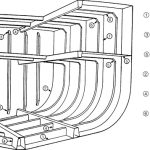- Keel: The keel is a member, or series of members, running longitudinally that forms the structural base of a ship. The keel always corresponds to a ship’s centreline. It is a major component in providing longitudinal strength and efficiently distributes local stresses when the ship is dry docked. There are two types of keels used to build ships of a certain size, the flat keel and the duct keel.
Flat keel

Duct keel

- Girders: A girder is a longitudinal member used in the construction of the bottom of a ship. They can be solid or not and can be placed above the keel (centre girder) or spaced equal distances from it (side girders). They can be continuous or divided by floor sections (intercostal side girders). The centre girder is always one continuous piece and must be fastened to the keel with a continuous weld. Girders must extend as far as possible from the forward to the aft end of a ship.
- Floors: These are made up of cross members that are mounted perpendicular to the keel and girders. There are three main types of floor: solid, plate and bracket.
Plate floor

Solid floor

Bracket or open floor

- Frames: These are vertical members that make up the framing of the vertical part of the hull. Frame type and spacing vary considerably depending on the ship’s construction.
Shell framing

- Deck beams: These are transverse members that connect the top ends of the frames, forming the transverse framing for the deck.


Comments are closed